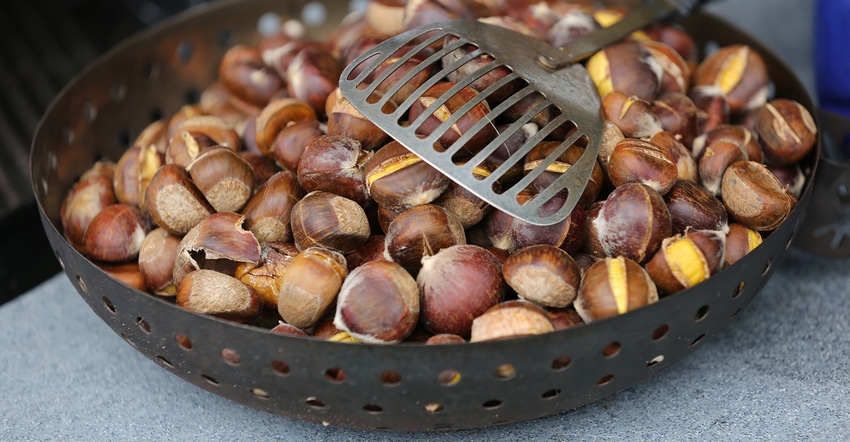
Chestnuts. They can be roasted on an open fire or cooked in hummus but first you must get the meat out of the tough brown shell.
The University of Missouri Center for Agroforestry offers instructions on how to prepare chestnuts for consumption. Here are three ways to treat yourself to chestnuts this holiday season.
Roasted on open fire
Prepare a charcoal fire on your BBQ grill. Propane could also be used, but the charcoal gives the nuts an additional smoky flavor. With a knife or a hand pruner garden tool, cut a ¼ inch deep slit on the flat side of each nut. This will allow the heated moisture to escape from inside the chestnut and will prevent them from exploding when heated on the fire.
Place the cut nuts in a metal pan such as a stainless steel wok or a cast iron skillet and place the pan on the grilling rack. While roasting, turn the nuts frequently with a metal spatula. Roasting the nuts will take about 20 minutes. When cooled, the shells will become brittle and be easy to peel with your fingers.
The nuts can also be roasted on a bonfire by using a long-handled metal pan. The nuts will only take about 5-10 minutes to cook over a hot fire or coals, and they must be turned frequently to prevent scorching of the shells and meat.
Steaming removal
The raw chestnut meats can be boiled and used for a wide variety of recipes. Before removing the raw meats, bring chestnuts to room temperature. Next, wash chestnuts to remove any dirt. Cut fresh chestnuts still in their shell in half with a hand pruner garden tool. A hand pruner works much better than attempting to cut them in half with a knife.
The steaming method has been found to be the most effective method for easily separating the shells from the meat. Place cut chestnuts in a collapsible steaming basket placed in a pan with approximately ½ inch of water. Bring water to a boil and steam the chestnuts until the meats separate from the shell. The chestnuts will be slightly cooked but still crunchy at this point. You can continue steaming the nuts to reach the desired level of crunchiness or continue to steam them until they are a soft consistency.
Meat extraction from shell
Bring chestnuts to room temperature. Cut fresh chestnuts in half with a hand pruner garden tool. Spread cut chestnuts out in a single layer in a glass pan containing a small amount of water. Microwave in most ovens for 60 seconds and remove from microwave. Overcooking makes it difficult to separate meat from the shell.
Cool slightly. Many of the meats will have separated from the shell and the thin tan-colored pellicle. If none have separated, microwave for 60 more seconds. For those that do not separate completely, squeeze on the edges of the shell and the meat should pop out. The meats are not cooked at this point and further preparation such as boiling or baking is necessary to make them soft and suitable for using in dishes containing fresh chestnut meats.
About the Author(s)
You May Also Like






